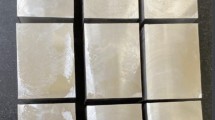Abstract
Cutting parameters have a significant influence on the surface finish after turning, which can generate unwanted surface roughness. Thus, the parameters optimization could be a favorable strategy to improve the machined part quality. Therefore, the optimization of the cutting speed (vc), feed rate (f) and depth of cut (ap) on finish turning of 6082-T6 aluminum alloy using an uncoated carbide tool (positive rake angles and 0.4 mm tip radius) under dry and reduced quantity lubricant (RQL) conditions was performed. The input variables were combined and randomized via Box–Behnken design of experiments. The surface roughness profiles were recorded, and the roughness parameters Ra and Rz were measured in each combination of parameters. After optimization, the best results of Ra (0.44 μm) and Rz (2.73 μm) after dry machining were obtained with vc = 851 m/min, f = 0.07 mm/rev. and ap = 2 mm. Since RQL machining, the correspondent levels (vc = 403 m/min, f = 0.05 mm/rev., ap = 0.5 mm) resulted in the lowest values of Ra (0.18 μm) and Rz (0.96 μm). The RQL favored the chip formation in turning of AA6082-T6, minimized the occurrence of grooves (scratches), burrs and waviness on the machined surface and generated better surface quality.









Similar content being viewed by others
References
Porto AJV et al (2000) Roughness and luminous scattering on turned aluminum surfaces with monocrystalline diamond tools. National Congress of Mechanical Engineering (CONEM). www.abcm.org.br/anais/conem/2000/OC8850.pdf
Jeswiet J et al (2008) Metal forming progress since 2000. CIRP J Manuf Sci Technol 1:2–17. https://doi.org/10.1016/j.cirpj.2008.06.005
Diniz AE, Marcondes FC, Coppini NL (2013) Tecnologia da Usinagem dos Materiais, 8th edn. Artliber, São Paulo
Ruan Y et al (2012) Mechanical properties and microstructures of 6082-T6 joint welded by twin wire metal inert gas arc welding with the SiO2 flux. Mater Des 35:20–24. https://doi.org/10.1016/j.matdes.2011.09.002
Kumar V, Kumar D (2017) Investigation of tensile behavior of cryorolled and room temperature rolled 6082 Al alloy. Mater Sci Eng A 691:211–217. https://doi.org/10.1016/j.msea.2017.03.051
Machado AR et al (2011) Teoria da Usinagem dos Materiais, 2nd edn. Blucher, São Paulo
Kishawy HA et al (2005) Effect of coolant strategy on tool performance, chip morphology and surface quality during high-speed machining of A356 aluminum alloy. Int J Mach Tool Manuf 45:219–227. https://doi.org/10.1016/j.ijmachtools.2004.07.003
Maher I et al (2014) Investigation of the effect of machining parameters on the surface quality of machined brass (60/40) in CNC end milling-ANFIS modeling. Int J Adv Manuf Technol 74:531–537. https://doi.org/10.1007/s00170-014-6016-z
Barzani MM et al (2015) Investigating the machinability of Al–Si–Cu cast alloy containing bismuth and antimony using coated carbide insert. Measurement 62:170–178. https://doi.org/10.1016/j.measurement.2014.10.030
Davoodi B, Tazehkandi AH (2014) Experimental investigation and optimization of cutting parameters in dry and wet machining of aluminum alloy 5083 in order to remove cutting fluid. J Clean Prod 68:234–242. https://doi.org/10.1016/j.jclepro.2013.12.056
Eapen J, Murugappan S, Arul S (2017) A study on chip morphology of aluminum alloy 6063 during turning under pre cooled cryogenic and dry environments. Mater Today Proc 4:7686–7693. https://doi.org/10.1016/j.matpr.2017.07.103
Kuram E, Ozcelik B, Demirbas E (2013) Environmentally friendly machining: vegetable based cutting fluids, green manufacturing processes and systems. Springer, Berlin, pp 23–47. https://doi.org/10.1007/978-3-642-33792-5
Camposeco-Negrete C (2015) Optimization of cutting parameters using Response Surface Method for minimizing energy consumption and maximizing cutting quality in turning of AISI 6061 T6 aluminum. J Clean Prod 91:109–117. https://doi.org/10.1016/j.jclepro.2014.12.017
Jayaramanaand P, Kumar LM (2014) Multi-response optimization of machining parameters of turning AA6063 T6 aluminium alloy using grey relational analysis in Taguchi method. Procedia Eng 97:197–204. https://doi.org/10.1016/j.proeng.2014.12.242
Murugappan S, Arul S, Narayanan SK (2015) Experimental study on turning of AL6063 under cryogenic precooled condition. Proc CIRP 35:61–66. https://doi.org/10.1016/j.procir.2015.08.048
Yamane Y et al (2017) A new quantitative evaluation for characteristic of surface roughness in turning. Precis Eng 50:20–26. https://doi.org/10.1016/j.precisioneng.2017.04.009
Torres A, Puertas I, Luis CJ (2015) Surface roughness analysis on the dry turning of an Al–Cu alloy. Procedia Eng 132:537–544. https://doi.org/10.1016/j.proeng.2015.12.530
Benardos PG, Vosniakos G-C (2003) Predicting surface roughness in machining: a review. Int J Mach Tool Manuf 43:833–844. https://doi.org/10.1016/S0890-6955(03)00059-2
Santos RGS (2011) Study of the influence of the application of cutting fluid in machining of AA 7075 aluminum alloy. 65 f. Dissertation, Master’s degree in Mechanical Engineering, UNESP, Guaratinguetá, SP, Brazil. http://hdl.handle.net/11449/121035 (in Portuguese)
Moreira LTS (2012) Influence of the application of cutting fluid in turning AA 7075 aluminum alloy, 114 f. Dissertation, Master’s degree in Mechanical Engineering, UNESP, Guaratinguetá, SP, Brazil. http://hdl.handle.net/11449/94423 (in Portuguese)
Sreejith PS (2008) Machining of 6061 aluminium alloy with MQL, dry and flooded lubricant conditions. Mater Lett 62:276–278. https://doi.org/10.1016/j.matlet.2007.05.019
Gonçalves RA (2012) Investigation of the machinability of aluminum alloys of the 6xxx series, 124 f. Dissertation, Master’s degree in Mechanical Engineering, UFU, Uberlândia, MG, Brazil. https://repositorio.ufu.br/bitstream/123456789/14911/1/d.pdf (in Portuguese)
Montgomery DC (2013) Design and analysis of experiments, 8th edn. Wiley, New York
Ferreira SLC et al (2007) Statistical designs and response surface techniques for the optimization of chromatographic systems. J Chromatogr A 1158:2–14. https://doi.org/10.1016/j.chroma.2007.03.051
ISO 4288 (1996) Geometrical product specifications (GPS)—surface texture: profile method—rules and procedures for the assessment of surface texture. International Organization for Standardization, 12 f
Acknowledgements
The authors thank to Quimatic/Tapmatic Co., for donation of nebulizer and cutting fluid; to Foundry Laboratory (LAFUN-UFRGS), for the chemical analysis and to CAPES (Grant 2017/1691358), for the student scholarship.
Author information
Authors and Affiliations
Corresponding author
Additional information
Technical Editor: Márcio Bacci da Silva, Ph.D..
Publisher's Note
Springer Nature remains neutral with regard to jurisdictional claims in published maps and institutional affiliations.
Rights and permissions
About this article
Cite this article
Garcia, R.F., Feix, E.C., Mendel, H.T. et al. Optimization of cutting parameters for finish turning of 6082-T6 aluminum alloy under dry and RQL conditions. J Braz. Soc. Mech. Sci. Eng. 41, 317 (2019). https://doi.org/10.1007/s40430-019-1826-4
Received:
Accepted:
Published:
DOI: https://doi.org/10.1007/s40430-019-1826-4




